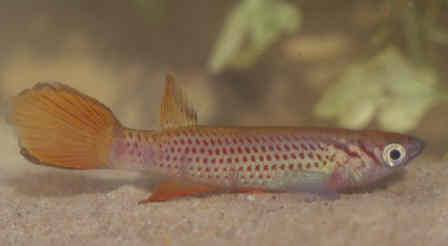
Epiplatys infrafasciatus zenkeri Ahl 1928

Wild Orange form caught at Dehane.
Found in a commercial import around 2000.
| Meaning of Name |
After Zenker who owned a large plantation at Bipindi, Cameroon. |
||||||||||||||||||||||
| First Description |
Ahl, E. 1928 Beiträge zur Systematik der afrikanischen
Zahnkarpfen. Zoologischer Anzeiger 79 (3-4): 113 - 123 |
||||||||||||||||||||||
| Size |
8 cm ( males). |
||||||||||||||||||||||
| Meristics | |||||||||||||||||||||||
| Karyotype |
|
||||||||||||||||||||||
| Sub-Genus |
|
||||||||||||||||||||||
| Group |
sexfasciatus |
||||||||||||||||||||||
| Synonyms |
|
||||||||||||||||||||||
|
Population
|
Bidjouka I - Collected in 1998 by Kämpf, Eberl & Kliesch - KEK 98 / 13. Collection site was a stream called the Toumatanga. Situated 12 kms from Bipindi. This is in the Lekoundje drainage. South of this site lies the village of Bipindi II.
Bidou -
Bissiang - This could be a different spelling as a village called Bisyang appears on maps which is close to Bidou I on the Kribi-Lolodorf road between Bidou I & Kribi. From a commercial import around 1998/9. Roger Gladwell gives a report on fish I gave him around this time in BKA newsletter No.431, August 2001. Spawnings in water of pH 6·9 - 7·1, 2-6 DH. Regular water changes are enjoyed by the fish. Eggs are clear & bright & laid near the surface in mops. Incubation in water was 12-16 days. First food was newly hatched brine shrimp. He found more fry would hatch if left in the parents tank but could be eaten by the parents. After a period of spawning it is best to remove the parents & let the fry grow on in this natural method.
Déhané -
Situated about halfway between Kribi & Edea on the N7 road, between
the road & the Nyong River. This location is north of the main
area of distribution for this subsp. & I call it here E.infrafasciatus
aff.zenkeri.
KEK 98 / 6 - Sometimes
seen as 'Baroi Kek'. This is a corruption. The population should be
called KEK 98 / 6. The baroi refers to a species name. At one time
baroi & rathkei
were known as seperate sub species but the names were sometimes added
when they were placed in infrafasciatus. Makondou - Originally distributed as E.sexfasciatus. First records suggest they came from the KCF & were distributed in the DKG. First reports of breeding suggest they were very hard to breed, as too were the baroi & a population G 80 / 12.
Makouré - Collected in 2 colour forms - one has a bright orange colour in unpaired fins, the other has yellow. Collection codes CBL 01 / 18 & BLLMC 05 / 26. Regarded as a harder population in the subspecies to breed. |
||||||||||||||||||||||
| Type Locality |
Bipindi, Southwest Cameroon (Zenkeri). Same collecting site as Fundulus pappenheimi Ahl 1924 (A.loennbergii). |
||||||||||||||||||||||
| Distribution |
Southeast Cameroon, between Kribi & Bipindi, in the Kienke river drainage. |
||||||||||||||||||||||
| Habitat |
|
||||||||||||||||||||||
| Distinguishing Characteristics |
This species has a solid orange anal fin.
E.infrafasciatus infrafasciatus has a dark outer marginal
bar in the anal. This fin also has a submarginal yellow band. |
||||||||||||||||||||||
| Colour/Pattern Variability | High | ||||||||||||||||||||||
| History |
Ahl had 3 specimens collected by Zenker at Bipindihof. The name confused many people but it turned out that this meant Bipindi house or house at Bipindi. Ahl named them Panchax zenkeri in 1928. Holly inspected these types & did not change the name. Myers in 1933 placed them in Epiplatys. This is a confusing history to this subsp. Generally
this website follows Wildekamp's work in his books 'A World of Killies'.
In this he places Epiplatys zenkeri
as a synonym for E.grahami. It is
listed in this page on the website as such. History of the synonym Panchax zenkeri Ahl 1928 Ahl described this sp. from 3 specimens
collected by Zenker at Bipindihof, southern Cameroon. In 1930 Holly
examined the preserved material but for once didn't change any of the
meristic data. This preserved material was found to be in a bad state.
In Myers' revision of 1933 he placed zenkeri
in Epiplatys. |
||||||||||||||||||||||
| Breeding Notes |
|
||||||||||||||||||||||
| Diameter of Egg | |||||||||||||||||||||||
| Remarks |
|